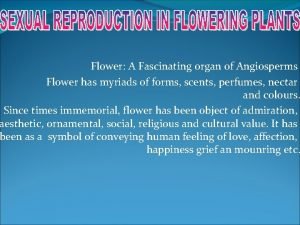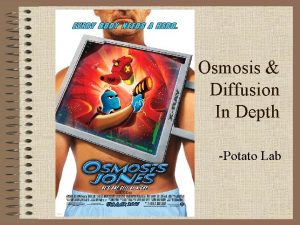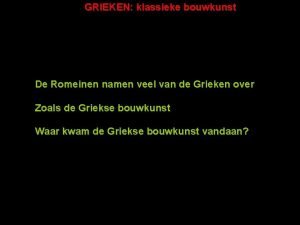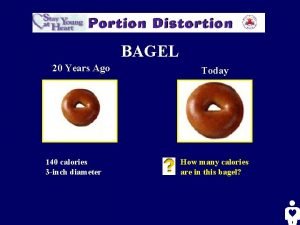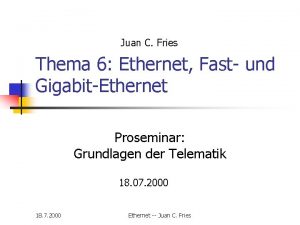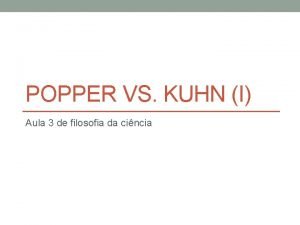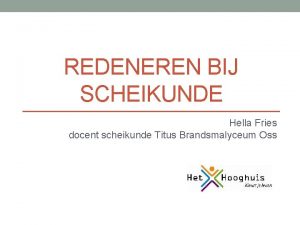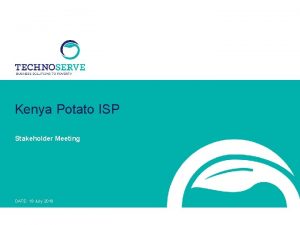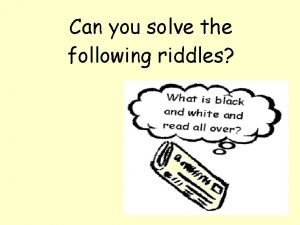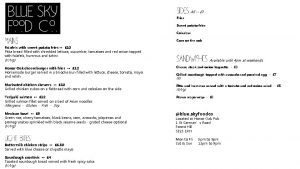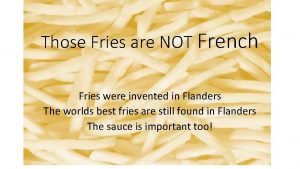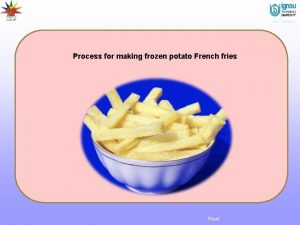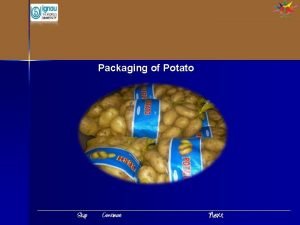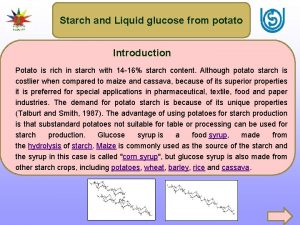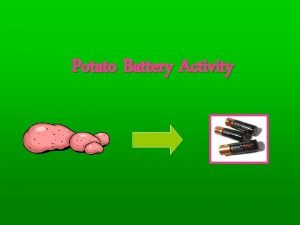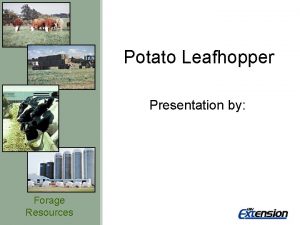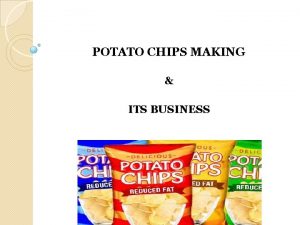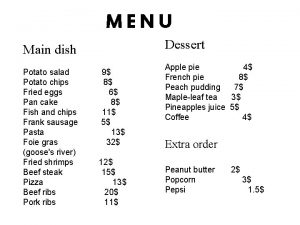From the potato to potato fries The fascinating


















- Slides: 18

From the “potato to potato fries” The fascinating history of the potato 1

WELCOME TO THE FASCINATING WORLD OF THE POTATO FRY Dear Teacher, If you are interested in discovering the world of the potato chip with your pupils, then you have come to the right place. Our mission is to provide you with all the information you need to prepare your visit and we guarantee you will find it extremely interesting. The guide book contains ready-made tools and ideas that will help you plan for this special day. We hope you have fun organising the visit with the aid of the guide book and we are sure you and your class will very much enjoy your excursion to the potato chip museum. Kind regards The Staff of the Potato Chip Museum 2

TABLE OF CONTENTS • • • • Introduction Table of Contents The Potato Chip Museum The Saaihalle The Medieval Cellar Question time How to make your reservation Price List An enjoyable visit The Potato Development Fund How to reach us Where to find us Reservation form Page 2 Page 3 Page 4 Page 5 Page 6 Pages 7, 8 and 9 Page 10 Page 11 Pages 12, 13 and 14 Page 15 Pages 16 and 17 Page 18 in attachment 3

THE POTATO CHIP MUSEUM The museum has on display more than 400 historical objects, the oldest dating from the pre-Colombian period. Information about these objects can be read on around fifty information boards and seen in several films. The museum is divided into three parts: • The history of the potato • The history of potato fries and potato fries in art • An opportunity to taste some delicious Belgian fries goes back some 10, 000 years (that is 8, 000 years before our era began). In Peru and Chile wild potatoes have been found in ancient tombs and prove that potatoes were already being used and most probably consumed by ancient tribes at that time. The museum explains how the potato went from its wild state to that of a cultivated plant and its fascinating journey from Peru to Europe. The history of potato fries: covering its past, its place in art, popular culture and its origins. We will also give you some advice on how to make the best potato fries. The opportunity to sample delicious Belgian fried potatoes in our medieval cellar. 4

The Saaihalle The Potato Chip Museum is housed in the “Saaihalle”. This magnificent building goes back to the 14 th century and many of its original features have survived to this day and are now preserved. It is also the oldest building in Bruges to have a date on its front wall. It is composed of two structures. The first part was built at the end of the 14 th century, in 1399 to be precise. At that time the town of Genoa used the building to house its commercial delegation in Bruges. The delegation members not only lived here but they also used the Saaihalle to store produce that was imported from Genoa and sold in Bruges. A second building was erected as an annex to the first in the 15 th century for the personal use of the Consul of Genoa. Whilst the interior of each building is on different floors, over the years the use of the two has gradually been merged into one and this has allowed us to create an interesting tour around the Potato Chip Museum. It is also of note that not only did the town of Genoa have a commercial delegation in Bruges, but so did Venice and Florence. 5

THE MEDIEVAL CELLAR You and your pupils will have the opportunity to sample potato chips in our medieval cellar. You and/or your school can choose between several different formulas. Each pupil will receive a voucher worth 40 euro-cents with his entrance ticket and which he can use to buy potato fries. The vouchers can be used individually or combined; 5 vouchers can be exchanged against a bag of potato fries. Or If you prefer to have lunch at the museum : The menu costs 5 Euros person and includes a bag of potato fries, a drink, a choice of sauces and an assortment of snacks. Please choose your menu in advance and let us know which one you want at least two days before your visit so that we can guarantee the quality of our service and products. 6

QUESTION TIME 1. “Chuno or Tunta” is an extremely clever method of conservation. What is its advantage? 2. How does the potato reproduce itself? 3. Name a succession of European countries through which the potato travelled. 4. To which family does the potato belong? 5. Which other vegetables also belong to this family? 6. How are potatoes cultivated? 7

QUESTION TIME 7. Who is the man in this photograph? 8. What is his profession? 9. Which country suffered from famine in 1845? 10. The first potatoes arrived at which Belgian port town? 11. The potato is a great source of which vitamin? 12. What is the maximum number of eggs the Colorado beetle can lay in a year? 8

QUESTION TIME 13. Potato fries originated in which region of Belgium? 14. Where does the denomination “French fries” come from? 15. Give a few tips on the best way to obtain delicious potato fries. 16. What is the name of the appliance in the photograph opposite and who invented it? 17. Give five different names for a “fritkot” 18. Who has a bag of potato fries on his head? 9

HOW TO MAKE YOUR RESERVATION Having read through this information booklet, we think you will now have a pretty good idea what to expect. So all that is left for you to do is to reply to the following questions and to send us your replies, preferably by email: • Date of your visit. • What time you want to start the visit (keeping in mind that the visit lasts around one hour and last entry is at 4. 15 pm). • The name of the person in charge (including the name of the person who will be accompanying the group and the name of the person who makes the reservation). • Administrative information (telephone, fax, mobile phone, email address). • The number of participants (number of pupils and their age, see the price list, as well as the number of accompanying adults). • Choice between sampling potato fries and group menu. • Do you want to book a guide (60 Euros per guide, maximum 20 people per guide per language)? • Payment (you can pay cash at the museum or pay at the end of the visit by bank transfer. For this we will need your invoice details). We do not accept credit cards. 10

PRICE LIST POTATO CHIP MUSEUM CHOCO-STORY OR LUMINA DOMESTICA POTATO CHIP MUSEUM CHOCO-STORY AND LUMINA DOMESTICA Students over 12 € 5, 00 € 9, 00 € 13, 00 Children between 6 and 11 € 4, 00 € 6, 00 € 9, 00 Children between 3 and 5 € 1, 00 € 2, 00 € 3, 00 11

OUR AIM IS TO MAKE YOUR VISIT AS PLEASANT AS POSSIBLE. At the museum, both pupils and accompanying adults can expect: • To be received in a friendly and helpful way • To find the museum clean and tidy • To be informed in advance of the rules and regulations in force at the museum • To receive all the information you need to make the most of your visit • To answer all your questions to the best of our ability • We inform you that the museum is under video surveillance 12

In return, the museum expects that pupils : • • • Behave in a courteous manner that respects the well-being of other visitors of the museum and its staff Respect the rules and regulations in force at the museum Leave the museum clean and tidy Do not have in their possession any object that could cause damage to the museum Understand that it is forbidden to smoke, eat or drink inside the museum except for food and drink that is bought and consumed in our chip shop Be responsible for their personal belongings during their visit to the museum The museum also expects that accompanying adults : • • Divide their class into groups of maximum 10 pupils Effectively accompany each group Bring the above-mentioned rules to the attention of pupils Be responsible for the observance of these rules 13

Punishable acts of damage • • Any action or behavior, whatever that may be, which is legally covered by Belgian law, will be considered as harm or offense (theft, destruction, defacement, dirtying) and liable to punishment. Pupils are expected to behave in such a way as not to cause any damage to the content of the museum or the building. Measures will be taken • • If the above-mentioned rules are not observed, the museum reserves the right to put an end to the visit In the case of any wrongdoings, the museum reserves the right to prosecute the guilty party according to law. THANK YOU FOR YOUR CONSIDERATION AND FOR BEING A GOOD FRIEND OF THE MUSEUM 14

THE POTATO DEVELOPMENT FUND • Inspired by the ideal created by the Choco-Story museum, that is their Cocoa Development Fund that helps third-world countries with the development of their local projects, the Chip Potato Museum has created its own Potato Development Fund. • The intention of the Chip Potato Museum is to participate in specific projects in the developing countries by helping local farmers to develop the cultivation and production of potatoes as a means of living to sustain their families. 15

HOW TO REACH US • If you are coming by train: When you leave the train station, go towards the town centre (turn left towards ‘t Zand) and you will come to a roundabout. Now pass by the statue of Albert 1 st and you will come to the ‘t Zand, near the concert hall (a modern, red-brick building). Take Zuidzandstraat that goes into Steenstraat and after another 500 metres you will reach the Market Square of Bruges. Walk diagonally across the square and you will come to the angle between Philipstockstraat and Vlamingstraat. Walk along Vlamingstraat for another 100 metres; half-way along you will pass by the old theatre situated on the left. Now you can make you way to the entrance of the Potato Chip Museum. If you prefer to take the bus rather than walk, check out the bus numbers. All the city buses go to Market Square except for number 23. 16

HOW TO REACH US • If you are coming by coach: On the Brussels-Ostend motorway, take the exit for Bruges and continue to the first set of traffic lights. After the traffic lights, turn right towards the town centre. At the first roundabout, carry straight on. Follow Koning Albert-I laan until you reach the roundabout after the Boeveriepoort and follow the direction to the Station on the Buiten Begijnvest. IMPORTANT: coaches have to park in the car park some 200 metres after the railway station. They can however drop pupils off at the Bargeplein (indicated on the map). • How to reach the museum from the Bargeplein on foot: Cross the Minnewaterpark and you will come to Arsenaalstraat. Turn right and carry straight on until you reach Katelijnestraat. Now turn left and walk towards the town centre. When you reach the Church of Our Lady, cross the road and walk along Mariastraat until you reach Simon Stevinplein. Cross the square diagonally and turn right onto Steenstraat. Carry on along Steenstraat and you will come to Market Square. Walk diagonally across the square and you will come to the angle between Philipstockstraat and Vlamingstraat. Walk along Vlamingstraat for another 100 metres; half-way along you will pass by the old theatre situated on the left. Now you can make your way to the entrance of the Potato Chip Museum. 17

WHERE TO FIND US Frietmuseum Vlamingstraat 33 8000 Brugge Tel. 050 / 34 01 50 Fax 050 / 34 31 50 E-mail : info@frietmuseum. be www. frietmuseum. be
 It's really fascinating
It's really fascinating It's really fascinating
It's really fascinating Flower a fascinating organ of angiosperms
Flower a fascinating organ of angiosperms Phrases of quantity
Phrases of quantity Every good boy deserves fries
Every good boy deserves fries Mc flavor fries
Mc flavor fries Potato lab hillview
Potato lab hillview Klassieke bouwkunst
Klassieke bouwkunst A fact statement
A fact statement Iras bagels
Iras bagels Juan fries
Juan fries Problema da demarcação
Problema da demarcação Hella fries
Hella fries Swot analysis of french fries
Swot analysis of french fries Potato fertilizer requirements
Potato fertilizer requirements Weekly quiz current events
Weekly quiz current events Solve the following riddles
Solve the following riddles Biotechnology examples
Biotechnology examples Potato irrigation management
Potato irrigation management


